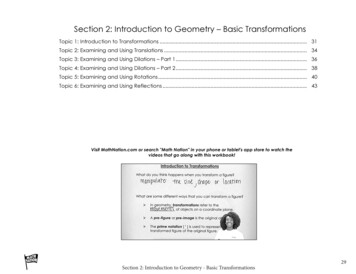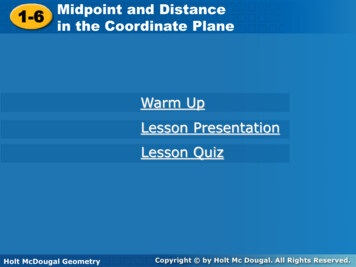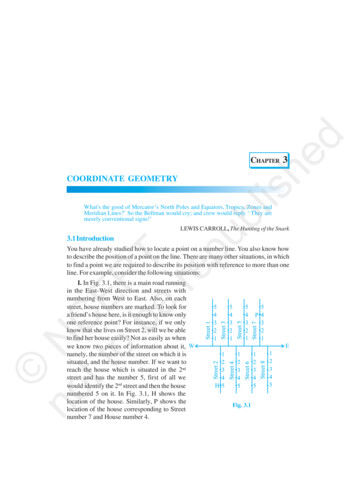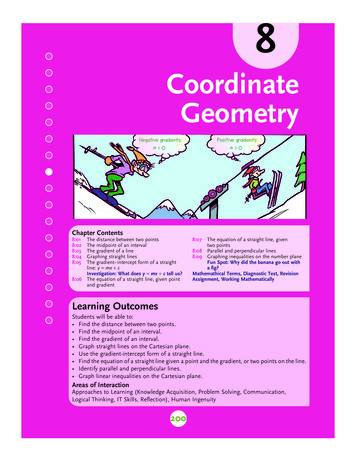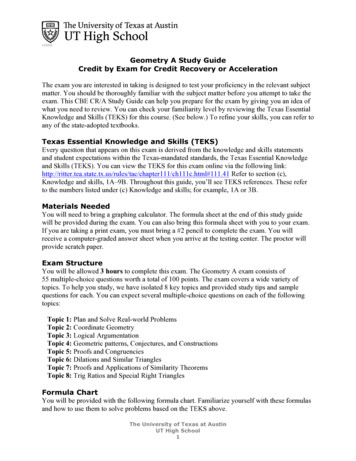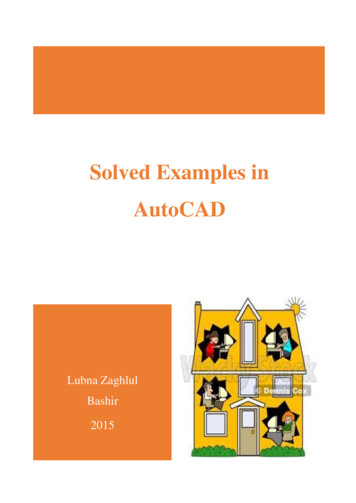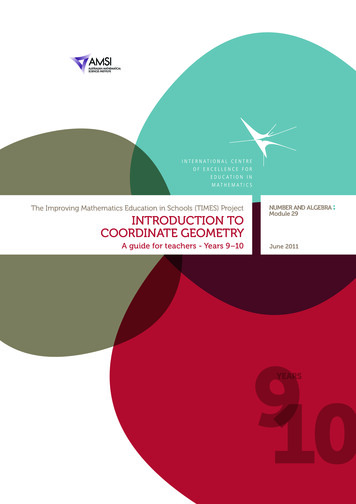
Transcription
The Improving Mathematics Education in Schools (TIMES) ProjectINTRODUCTION TOCOORDINATE GEOMETRYA guide for teachers - Years 9–10NUMBER AND ALGEBRAModule 29 June 2011910YEARS
Introduction to Coordinate Geometry(Number and Algebra : Module 29)For teachers of Primary and Secondary Mathematics510Cover design, Layout design and Typesetting by Claire HoThe Improving Mathematics Education in Schools (TIMES)Project 2009‑2011 was funded by the Australian GovernmentDepartment of Education, Employment and WorkplaceRelations.The views expressed here are those of the author and do notnecessarily represent the views of the Australian GovernmentDepartment of Education, Employment and Workplace Relations. The University of Melbourne on behalf of the InternationalCentre of Excellence for Education in Mathematics (ICE‑EM),the education division of the Australian Mathematical SciencesInstitute (AMSI), 2010 (except where otherwise indicated). Thiswork is licensed under the Creative Commons AttributionNonCommercial-NoDerivs 3.0 Unported License. 3.0/
The Improving Mathematics Education in Schools (TIMES) ProjectINTRODUCTION TOCOORDINATE GEOMETRYA guide for teachers - Years 9–10NUMBER AND ALGEBRAModule 29 June 2011Peter BrownMichael EvansDavid HuntJanine McIntoshBill PenderJacqui Ramagge910YEARS
{1}A guide for teachersINTRODUCTIONTO COORDINATEGEOMETRYASSUMED KNOWLEDGE Fluency with the arithmetic of the rational numbers Knowledge of ratios Congruent and similar triangles Basic algebraic notation Fluency with algebraic expressions and equations Basic plotting points in the Cartesian plane including plotting points from a table of values.MOTIVATIONCoordinate geometry is one of the most important and exciting ideas of mathematics.In particular it is central to the mathematics students meet at school. It provides aconnection between algebra and geometry through graphs of lines and curves. Thisenables geometric problems to be solved algebraically and provides geometric insightsinto algebra.The invention of calculus was an extremely important development in mathematics thatenabled mathematicians and physicists to model the real world in ways that was previouslyimpossible. It brought together nearly all of algebra and geometry using the coordinateplane. The invention of calculus depended on the development of coordinate geometry.CONTENTIt is expected that students have met plotting points on the plane and have plotted pointsfrom tables of values of both linear and non linear functions.The number plane (Cartesian plane) is divided into four quadrants by two perpendicularaxes called the x-axis (horizontal line) and the y-axis (vertical line). These axes intersect ata point called the origin. The position of any point in the plane can be represented by anordered pair of numbers (x, y). These ordered pairs are called the coordinates of the point.
The Improving Mathematics Education in Schools (TIMES) ProjectyThe point with coordinates (4, 2) has beenplotted on the Cartesian plane shown.The coordinates of the origin are (0, 0).4x-coordinate32Once the coordinates of two points areknown the distance between the two pointsand midpoint of the interval joining the pointscan be found.(4, 2)1–4 –3 –2 –1 0–1y-coordinate1234x–2–3–4DISTANCE BETWEEN TWO POINTSDistances are always positive, or zero if the points coincide. The distance from A to B isthe same as the distance from B to A. We first find the distance between two points thatare either vertically or horizontally aligned.EXAMPLEFind the distance between the following pairs of points.a A(1, 2) and B(4, 2)b A(1, –2) and B(1, 3)SOLUTIONa The distance AB 4 – 1 3yA(1, 2)Note: The distance AB is obtained fromthe difference of the x-coordinates ofthe two points.0b The distance AB 3 – (–2) 5yB(4, 2)xB(1, 3)Note: The distance AB is obtained fromthe difference of the y-coordinates of thetwo points.x0A(1, –2){2}
{3}A guide for teachersThe example above considered the special cases when the line interval AB is eitherhorizontal or vertical. Pythagoras’ theorem is used to calculate the distance between twopoints when the line interval between them is neither vertical nor horizontal.The distance between the points A(1, 2) and B(4, 6) is calculated below.yB(4, 6)A(1, 2)C(4, 2)0xAC 4 – 1 3 and BC 6 – 2 4.By Pythagoras’ theorem,AB2 32 42 25And soAB 5The general caseWe can obtain a formula for the length of any interval. Suppose that P(x1, y1) and Q(x2, y2)are two points.yQ(x2, y2)y2 – y1P(x1, y1)x2 – x1X(x2, y1)0xForm the right-angled triangle PQX, where X is the point (x2, y1),PX x2 – x1 or x1 – x2andQX y2 – y1 or y1 – y2depending on the positions of P and Q.By Pythagoras’ theorem:PQ2 PX2 QX2 (x2 – x1)2 (y2 – y1)2ThereforePQ QP (x2 – x1)2 (y2 – y1)2Note that (x2 – x1)2 is the same as (x1 – x1)2 and therefore it doesn’t matter whether we gofrom P to Q or from Q to P – the result is the same.
The Improving Mathematics Education in Schools (TIMES) ProjectEXAMPLEFind the distance between the points A(–4, –3) and B(5, 7).SOLUTIONIn this case, x1 –4, x2 5, y1 –3 and y2 7.AB2 (x2 – x1)2 (y2 – y1)2 (5 – (–4))2 (7 – (–3))2 92 102 181Thus, AB 181Note that we could have chosen x1 5, x2 –4, y1 7 and y2 –3 and still obtained thesame result. As long as (x1, y1) refers to one point and (x2, y2) the other point, it does notmatter which one is which.EXERCISE 1Show that the distance between the points A(a, b) and B(c, d) is the same as thedistance between the points P(a, d) and Q(c, b) the points U(b, a) and V(d, c)Illustrate both of these.EXERCISE 2The distance between the points (1, a) and (4, 8) is 5. Find the possible values of a and usea diagram to illustrate.THE MIDPOINT OF AN INTERVALThe coordinates of the midpoint of a line interval can be found using averages as we will see.We first deal with the situation where the points are horizontally or vertically aligned.EXAMPLEFind the coordinates of the midpoint of the line interval AB, given:a A(1, 2) and B(7, 2)b A(1, –2) and B(1, 3){4}
{5}A guide for teachersSOLUTIONya AB is a horizontal line interval, themidpoint is at (4, 2), since 4 is halfwaybetween 1 and 7.Note: 4 is the average of 1 and 7, that is, 4 12b The midpoint of AB has coordinates 1,Note that12A(1, 2)B(7, 2)1 72 .x0y.B(1, 3)is the average of 3 and –2.x0A(1, –2)When the interval is not parallel to one of the axes we take the average of thex-coordinate and the y-coordinate. This is proved below.yB(5, 8)8M(x, y)y20TA(1, 2)1Sx5xLet M be the midpoint of the line AB. Triangles AMS and MBT are congruent triangles(AAS), and so AS MT and MS BT.Hence the x-coordinate of M is the average of 1 and 5.x 5 12 3The y coordinate of M is the average of 2 and 8.x 2 82 5Thus the coordinates of the midpoint M are (3, 5).The general caseWe can find a formula for the midpoint of any interval. Suppose that P(x1, y1) and Q(x2, y2)are two points and let M(x, y) be the midpoint.
The Improving Mathematics Education in Schools (TIMES) ProjectyQ(x2, y2)y2M(x, y)yy1TP(x1, y1)x10Sxxx2Triangles PMS and MQT are congruent triangles (AAS), and so PS MT and MS QT.Hence the x-coordinate of M is the average of x1 and x2, and y-coordinate of M is theaverage of y1 and y2. Thereforex x1 x22and y y1 y22Midpoint of an intervalThe midpoint of an interval with endpoints P(x1, y1) and Q(x2, y2) isx1 x2 y1 y2, 22.Take the average of the x-coordinates and the average of the y-coordinates.EXAMPLEFind the coordinates of the midpoint of the line interval joining the points (6, 8) and (–3, 2).SOLUTIONThe midpoint has coordinates,6 (–3) 8 22 , 2 32,5EXAMPLEIf C(3, 6) is the midpoint of line interval AB and A has coordinates (–1, 1), find thecoordinates of B.SOLUTIONLet the coordinates of B be (x1, y1).x1 (–1)2 3 andy1 12 6x1 – 1 6 y1 1 12so x1 7 so y1 11.Thus B has coordinates (7, 11).{6}
{7}A guide for teachersEXERCISE 3A square has vertices O(0, 0), A(a, 0), B(a, a) and C(0, a).a Find the midpoint of the diagonals OB and CA.b Find the length of a diagonal of the square and the radius of the circle in which OABCis inscribed.c Find the equation of the circle inscribing the square.THE GRADIENT OF A LINEGradient of an intervalThe gradient is a measure of the steepness of line. There are several ways to measuresteepness. In coordinate geometry the standard way to define the gradient of an interval ABriseis run where rise is the change in the y-values as you move from A to B and run is the changein the x-values as you move from A to B. We will usually the pronumeral m for gradient.yB(5, 6)riseA(2, 1)run0xGiven the points A(2, 1) and B(5, 6):gradient of interval AB riserun 6–15–2 53Notice that as you move from A to B along the interval the y-value increases as the x-valueincreases. The gradient is positive.Given the points A(2, 7) and B(6, 1)gradient of interval AB riserunriseruny 1–76–2–64 7–12–6 –2 A(2, 7)3– 2orgradient of interval BA 3B(6, 1)0x
The Improving Mathematics Education in Schools (TIMES) ProjectNotice that in this case as we move from A to B the y value decreases as the x value3increases. The gradient is negative. Similarly the gradient of BA – 2 which is the same asthe gradient of AB.In general:yriserungradient of line interval AB m B(x2, y2)y2 – y1(rise)y2 – y1x2 – x1A(x1, y1)x2 – x1(run)x0y –yy –yNote that since x2 – x1 x1 – x2 it does not2112matter which point we take as the first andwhich point we take as the second.yIf the interval is vertical, the run is zeroand the gradient of the interval is notdefined. This is shown by interval AB.BQPIf the interval is horizontal, the rise is zeroas shown by interval PQ. The gradient ofthe interval is zero.A0xGradient of PQ is zeroGradient of AB is not definedGradient of a lineThe gradient of a line is defined to be the gradient of any interval within the line.This definition depends on the fact that two intervals on a line have the same gradient.yQBAPYX0xSuppose AB and PQ are two intervals on the same straight line. Draw right-angledtriangles ABX and PQY with sides AX and PY parallel to the x-axis and sides BX and QYparallel to the y-axis.Triangle ABX is similar to triangle PQY since the corresponding angles are equal.Therefore:QYPY BXAXThat is, the intervals have the same gradient.{8}
{9}A guide for teachersEXAMPLEA line passes through the points (1, 2) and (5, 10). Find its gradient.SOLUTIONgradient y2 – y1x2 – x1 10 – 25–1y(5, 10)10 – 2 8 2(1, 2)5–1 4x0EXAMPLE2A line passes through the point (5, 7) and has gradient 3 . Find the x-coordinate of a pointon the line when y 13.SOLUTIONGradient of the line 6x–5 6x – 5.(x, 13)yThus,13 – 723(5, 7)18 2(x – 5)9 x–5x 14x–5x0EXERCISE 4Find the gradient of the line passing through (a, b) and (0, c)InterceptsThe x-intercept of a line is the point at which it crosses the x-axis.The y-intercept of a line is the point at which it crosses the y-axis.yyyAC0Bx0xIn the diagram to the left the y-intercept is at A and the x-intercept at B.0Dx
The Improving Mathematics Education in Schools (TIMES) Project{10}The second diagram shows a line parallel to the x-axis and it has a y-intercept at C.The third diagram shows a line parallel to the y-axis and it has an x-intercept at D.EQUATION OF A STRAIGHT LINEWhen we plot points which satisfy the equationy 2x 1 we find that they lie in a straight line.y 2x 1y(2, 5)Can we find the equation of the line given suitablegeometric information about the line? The followingshows that this can be done given the gradient of theline and the y-intercept.(1, 3)(0, 1)(–1, –1)x0THE LINE y 3X 2Consider the line with gradient 3 and y-intercept 2. This passes through the point A(0, 2).Let B(x, y) be any point on this line.Gradient of interval AB riserun y–2x–0 y–2xyB(x, y)A(0, 2)The gradient of the line is 3.y–2 xSo,Rearrangingx03y – 2 3xy 3x 2So the coordinates of B(x, y) satisfies y 3x 2. This is called the equation of the line.yConversely suppose that B(x, y) satisfies the equation y 3x 2, then x –– 02 3 and itpasses the point (0, 2) so the point lies on the line with gradient 3 and y-intercept 2.We summarise this by saying that the equation of the line is y 3x 2.THE EQUATION y mx cConsider the line with gradient m and y-intercept c. If passes through the point A(0, c).Let B(x, y) be any point on this line.Gradient of interval AB y–cx–0 y–cxyB(x, y)A(0, c)We know the gradient of the line is m.0x
{11}A guide for teachersThereforey–cx my – c mxy mx cThat is, the line in the cartesian plane with gradient m and y-intercept c has equationy mx c. Conversely, the points whose coordinates satisfy the equation y mx calways lie on the line with gradient m and y-intercept c.Vertical and horizontal linesVertical linesIn a vertical line all points have the same x-coordinate, but the y-coordinate can take anyvalue. The equation of the vertical line through the point (6, 0) is x 6. The x-axis interceptis 6. All the points on this line have x-coordinate 6.y(6, 0)0xIn general, the equation of the vertical line through P(a, b) is x a.Because this line does not have a gradient it cannot be written in the formy mx b.Horizontal linesA horizontal line has gradient 0. In a horizontal line all points have the same y-coordinate,but the x-coordinate can take any value. The equation of the horizontal line through thepoint (0, 5) is y 5. The equation of the horizontal line through the point (9, 5) is y 5.y(0, 5)0xIn general, the equation of the horizontal line through P(a, b) is y b.
The Improving Mathematics Education in Schools (TIMES) ProjectEXAMPLEWrite down the gradient and y-intercept of the line with equation y 3x – 4.SOLUTIONThe gradient of the line is 3 and the y-intercept is –4.Sometimes an equation needs to be rearranged before the gradient and y-intercept canbe determined. Consider the following example.EXAMPLERewrite the equation 2x 3y 6 in the form y mx c and hence find the value of thegradient and y-intercept.SOLUTION2x 3y 6so3y 6 – 2xthat is,y 2 – 2x3Thusy –2x 232The gradient of the line is – 3 and the y-intercept is 2.Equation of a line given its gradient and a point on the lineWe want to find the equation of the linewith gradient m and which passes throughthe point P(x1, y1).yP(x, y)y – y1(rise)Let P(x, y) be any point with x x1 on the linepassing through the point A(x1, y1) and let mbe the gradient of this line.Using gradient, m andy – y1x – x1A(x1, y1)x – x1(run)0xy – y1 m(x – x1)This is the equation of the straight line with gradient m passing through the point A(x1, y1).EXAMPLEFind the equation of the line that passes through the point (–2, 3) with gradient –4.SOLUTIONThe equation for this line is:y – y1 m(x – x1)y – 3 –4(x – (–2)){12}
{13}A guide for teachersthat is,y – 3 –4x – 8y –4x – 5Note that it is usual to give the answer in the form y mx cEquation of a straight line given two pointsGiven two points A(x1, y1) and B(x2, y2) the equation of the line passing through the twopoints can be found.The gradient m of the line passing through A(x1, y1) and B(x2, y2) y2 – y1x2 – x1 , x2 x1Substituting into y – y1 m(x – x1) givesy – y1 y2 – y1x2 – x1 (x– x1) ,x2 x1GRAPHING STRAIGHT LINESUsing the equation to sketch the lineIf you are given an equation of a straight line and asked to draw its graph all you need todo is find two points whose coordinates satisfy the equation and plot the points. There aretwo commonly used methods to find two points.Using the y-intercept and one other pointUsing the y-intercept and a second point the equation can be found .EXAMPLEDraw the graph of y 2x 3.SOLUTIONThe y-intercept is 3 and the gradient 2.Substitute x 1, so y 5 giving the point (1, 5)lies on the line.y2(0, 3)1Plot the two points and draw the line through them.This method does not work if the line is parallel to the y-axis.(1, 5)0x
The Improving Mathematics Education in Schools (TIMES) ProjectEXAMPLEThe gradient of a line is –6 and the y-intercept is 2. Find the equation of the line andsketch it.SOLUTIONUsing the y mx c form for the equation of a straight line.yThe equation of the line is y –6x 2.2The point (0, 2) lies on the line.Substitute x 1 in y –6x 2x0 –6 1 2A(1, –4) –4The point (1, –4) lies on the line. The graph is shown.x-intercept y-intercept methodIn this method both intercepts are found. The x-intercept is found by substituting y 0 and The y-intercept is found by substituting x 0.This method does not work if the line is parallel to an axis or passes through the origin.EXAMPLEUsing the x-intercept y-intercept method sketch the graph of:a y 3x – 4b 2x 3y 6 0SOLUTIONya When x 0,When y 0,43y –43x – 4 003x 4x 43y 3x – 4–4x{14}
{15}A guide for teachersb When x 0,3y 6 02x 3y 6 03y 6y –2When y 0,–3y0x2x 6 0–22x –6x –3The general form for the equation of a straight lineThe equations y 2x – 3, x 6 and 2x – 3y 6 can be written as –2x y 3, x – 6 0and 2x – 3y – 6 0 respectively.The general form for the equation of a line is ax by c 0 where a, b and c areconstants and a 0 or b 0. The equation of every line can be put in general form. Thegeneral form is not unique. The equation x 2y 1 0 is the same straight line as2x 4y 2 0.EXERCISE 5An equilateral triangle ABC has coordinates O(0, 0), B(a, 0) and C(c, d).a Find c and d in terms of a by using the fact that OB BC CO.b Find the equation of the lines OB, BC and CO.PARALLEL AND PERPENDICULAR LINESParallel linesIf two lines l1 and l2 are parallel then corresponding angles are equal.Conversely, if corresponding angles are equal then the lines are parallel.l1l2TheoremTwo lines are parallel if they have the same gradient and conversely,two lines with the same gradient are parallel.ProofIn the diagram, two lines are drawn and the right-angled triangles PQX and ABY areadded with QX BY.
The Improving Mathematics Education in Schools (TIMES) ProjectyPQAB0XYxIf the lines are parallel then /PQX /ABY (corresponding angles).The two triangles are congruent by the AAS test.PXTherefore PX PY and QX AYBY .That is, the gradients are equal.PXConversely. If the gradients are equal QX AYBY .Now QX BY and therefore PX AY.Hence the triangles QPX and ABY are congruent by the SAS test.Hence the corresponding angles PQX and ABY are equal and the lines are parallel.EXAMPLEShow that the line passing through the points A(6, 4) and B(7, 11) is parallel to the linepassing through P(0, 0) and Q(2, 14).SOLUTIONGradient of AB 11 – 47–6Gradient of PQ 14 – 02–0 7 7The two lines have the same gradient and so are parallel.EXAMPLEFind the equation of the line that is parallel to the line y –2x 6 and passing through thepoint A(1, 10).SOLUTIONThe gradient of the line y –2x 6 is –2.Therefore the line through the point A(1, 10) parallel to y –2x 6 has equation:y – y1 m(x – x1)y – 10 –2(x – 1)y –2x 12{16}
{17}A guide for teachersPerpendicular linesWhen we draw y 3x and draw a line perpendicular to it passing through the origin thenit is clear that y –ax where a is a small positive number. We will show that the equation is1y – 3 x.We are now going to show the surprising result that ‘if two lines are perpendicular thenthe product of their gradients is –1’ (or if one is vertical and the other horizontal). Theconverse is also true. That is, ‘ If the product of the gradients of two lines is –1 then theyare perpendicular’.We first consider the case when both lines pass through the origin.Draw two lines passing through the origin with one of the lines having positive gradientand the other negative gradient.yPQAOBxForm right-angled triangles OPQ and OAB with OQ OB.ABGradient of the line OA OBOQGradient of the line through OP – PQOQABOQABOQThe product – PQ OB – PQ (since OQ OB)AB – PQIf the lines are perpendicular, /POQ /AOB.y90 –QAOBPx
The Improving Mathematics Education in Schools (TIMES) ProjectTherefore OPQ OAB (AAS),ABso PQ AB and the product, – PQ , of the gradients is –1.Conversely If the product is –1, then AB PQ,so OAB OPQ (SAS).Therefore /POQ /AOB and so /AOP 90 .We have now proved the result for lines through the origin.If we are given two lines anywhere in the plane, we can draw lines through the originparallel to the given two lines. The gradient of each new line is the same as the gradientof the corresponding original line. So the result holds for lines that do not necessarily passthrough the origin.EXAMPLEShow that the line through the points A(6, 0) and B(0, 12) is perpendicular to the linethrough P(8, 10) and Q(4, 8).SOLUTIONGradient of AB 12 – 00–6 –2Gradient of PQ 10 – 88–42412(Gradient of AB) (gradient of PQ) –2 12 –1Hence the lines are perpendicular.Parallel and perpendicular lines If two non-vertical lines are parallel then they have the same gradient.Conversely if two non-vertical lines have the same gradient then they are parallel. If two non-vertical lines are perpendicular then the product of their gradientsis –1. Conversely if the product of the gradients of two lines is –1 then they areperpendicular.{18}
{19}A guide for teachersEXAMPLEFind the equation of the line which passes through the point (1, 3) and is perpendicular tothe line whose equation is y 2x 1.SOLUTIONGradient of the line y 2x 1 is 2.1Gradient of a line perpendicular to this line is – 2 .1The required equation is y – 3 – 2 (x – 1)2(y – 3) –(x – 1)2y x 7Thus the equation of the required line is 2y x 7.PROOFS WITH COORDINATE GEOMETRYCoordinate geometry can be used to prove results in Euclidean Geometry. An important aspectof doing this is placing objects on the Cartesian plane in a way that minimises calculations.EXAMPLEProve that the midpoints of a parallelogram bisect each other using coordinate geometry.SOLUTIONLet the coordinates of the vertices be O(0, 0), A(a, 0), B(a c, d) and C(c, d).There is no loss in generality in placing the vertices of the parallelogram on the Cartesianplane in this way.The midpoint M of OB a c d2 , 2The midpoint N of AC a c d2 , 2M N and so the midpoints coincided which means that the diagonals bisect each other.EXAMPLEProve that the diagonals of a rhombus bisect each other at right angles using coordinategeometry.SOLUTIONLet the coordinates of the vertices be O(0, 0), A(a, 0), B(a c, d) and C(c, d).Because it is a rhombus all the sides are of equal length.
The Improving Mathematics Education in Schools (TIMES) ProjectOA AB BC COdGradient of OB a c and,dGradient of AC c – adThe product of the gradients of the diagonals a c dd2c – a c2 – a2 .OA2 a2 and by Pythagoras’ theorem, AB2 c2 d2so a2 c2 d2.Hence d2 –(c2 – a2)Thus the product of the gradients of the diagonals –1.EXERCISE 6In any triangle ABC prove that AB2 AC2 2(AD2 DC2)Where D is the midpoint of BC.EXERCISE 7Prove that set of points equidistant from two given points is a straight line.EXERCISE 8Prove that the lines joining the midpoints of opposite sides of a quadrilateral and the linesjoining the midpoints of its diagonals meet in a point and bisect each other.LINKS FORWARDCoordinate geometry leads into many other topics in school mathematics. Thetechniques of coordinate geometry are used in calculus, functions, statistics and manyother important areas.HISTORYThere were three facets of the development of coordinate geometry. The invention of a system of coordinates The recognition of the correspondence between geometry and algebra The graphic representation of relations and functions{20}
{21}A guide for teachersThe Greek mathematician Menaechmus (380–320 BC) proved theorems by using amethod that was very close to using coordinates and it has sometimes been maintainedthat he had introduced coordinate geometry.Apollonius of Perga (262–190 BC) dealt with problems in a manner that may be calledan coordinate geometry of one dimension; with the question of finding points on a linethat were in a ratio to the others. The results and ideas of the ancient Greeks provided amotivation for the development of coordinate geometry.Coordinate geometry has traditionally been attributed to René Descartes (1599–1650) andPierre de Fermat (1601–1665) who independently provided the beginning of the subject aswe know it today.ANSWERS TO EXERCISESEXERCISE 1AB2 PQ2 UV2 (d – b)2 (c – a)2V(d, t)yyP(a, d)B(c, d)A(a, b)Q(c, b)B(c, d)C(b, a)A(a, b)x0y xx0EXERCISE 2a 4 or a 12yA(1, 12)(4, 8)B(1, 4)0xEXERCISE 3aa a2, 2b diagonal 2a, radius 2a2cx–a22 y–a22 a22
The Improving Mathematics Education in Schools (TIMES) ProjectEXERCISE 4b–caEXERCISE 5a c 2a , d 3a2ddb OA: y 0, OC: y c , OB: y c – a(x – a)EXERCISE 6Place the triangle so D is at the origin. Then let the coordinates of B and C be (–a, 0) and(a, 0) respectively. Let the coordinates of A be (d, c).AB2 c2 (d a)2 and AC2 c2 (d – a)2AB2 AC2 2c2 2d2 2a2SoAD2 c2 d2 and DC2 a2HenceAB2 AC2 2(AD2 DC2)EXERCISE 7Let P(x, y) be a point equidistant from A(a, b) and C(c, d)PA PC2(c – a)x 2(d – b)y d2 c2 – a2 – b2EXERCISE 8Let the coordinates of the vertices be O(0, 0), A(a, c), B(m, n) and D(b, 0)Show that the midpoint of all the required line segments has coordinates1(m4 b a), 41 (n c){22}
The aim of the International Centre of Excellence forEducation in Mathematics (ICE-EM) is to strengtheneducation in the mathematical sciences at all levelsfrom school to advanced research and contemporaryapplications in industry and commerce.ICE-EM is the education division of the AustralianMathematical Sciences Institute, a consortium of27 university mathematics departments, CSIROMathematical and Information Sciences, the AustralianBureau of Statistics, the Australian Mathematical Societyand the Australian Mathematics Trust.The ICE-EM modules are part of The ImprovingMathematics Education in Schools (TIMES) Project.The modules are organised under the strandtitles of the Australian Curriculum: Number and Algebra Measurement and Geometry Statistics and ProbabilityThe modules are written for teachers. Each modulecontains a discussion of a component of themathematics curriculum up to the end of Year 10.www.amsi.org.au
The Improving Mathematics Education in Schools (TIMES) Project NUMBER AND ALGEBRA Module 29 A guide for teachers - Years 9-10 June 2011. Introduction to Coordinate Geometry . 2 and therefore it doesn't matter whether we go from P to Q or from Q to P - the result is the same. The Improving Mathematics Education in Schools (TIMES) Project {4}
